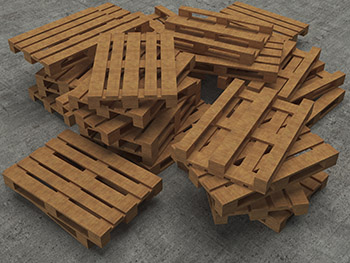
Cardboard and boxes, bubble wrap and pallets. Rethinking packaging design revolutionizes logistics costs and delivery quality. (Oh, and by the way, it saves money, too!)
According to packaging guru Professor Diana Twede at Michigan State, packaging engineer Kevin Howard earned a bucket of gold stars when in a breakthrough creativity moment he dreamed up a new way for HP to ship Deskjet printers — pallet-less. Not only did his concept reduce the weight, and therefore shipping costs for HP and its customers, but it took logistics and packaging on a whole new path toward “self-packing” designs.
Postponement
Howard recalls working late one November evening when an idea struck him. He yelled out from his cubicle — a co-worker ran over to see if everything was okay. Howard knew that something was afoot — at least for HP — because packaging was about to take a new turn.
“This was a completely new approach,” said Howard. “Most companies design a product thinking about functionality and aesthetics, but very few think about the impact on logistics costs that results from having a product with low fragility, meaning it can be easily broken or made unacceptable to the consumer in some way, or size/geometry that results in larger-than-optimal packaging. If the product is electromechanical, cushioning is often added until the packaged unit passes some pre-defined laboratory drop and vibration testing. I call this approach Design From the Inside Out.”
We’ve seen what happens when new product designs suddenly accumulate cost and damage because packaging design was an afterthought on the new product design highway. And the solution may be tied into simple “landed cost” calculations.
“The problem,” said Howard, “is that shipping costs may be completely ignored in the development phases of a new product. Logistics costs often get hidden from corporate management when companies make R&D managers responsible for the individual component costs and assembly costs — but not the landed cost — of the final product to the final consumer.”
Is there a better way?
Nobody wants expensive surprises at launch time, and that’s where Howard’s breakthrough approach changes the way we look at the new product design cycle. Now we’re looking at packaging in addition to manufacturing costs. “I call it Design From the Outside In,” he said, “and it’s what drives all my designs.”
Each shipping mode has different size and dimension parameters, and Howard’s Design From the Outside In is intended to match the right packaging design and material with the particular shipping method.
“There are certain fixed aspects of distribution logistics — the size of airplane cargo holds, ocean containers, trucks on different continents, pallets on different continents — and yet many companies fail to take full advantage of these various fixed spaces. For instance, standard U.S. pallets are 48" x 40", which fit well into U.S. trucks that are 101 inches wide and 53 feet long, but they leave significant empty space in standard 40-foot ocean containers and air cargo cookie sheets.
These differences are the nitty-gritty of packing engineering, and it’s easy to see what happens when product designers are unaware of end shipping modes, or packaging design is not represented in the development cycle.
Uncovering waste in the process
“Many U.S. pallets are simply disposed of once they reach Europe, where products are then transferred onto standard reusable pallets measuring 1200 x 1000 (47.25" x 39.4") or 1200 x 800,” warned Howard. “If the U.S. package fits perfectly onto the U.S. pallet, it will have overhang in Europe, resulting in some amount of crushing damage to the bottom boxes. U.S. pallets simply do an awful job of fitting onto air cargo cookie sheets, so freight forwarders remove products from expensive pallets and simply hand stack lots of boxes into the void spaces, thus guaranteeing excess handling that inevitably increases damage rates.
But each supply chain, as purchasing and logistics pros know, is different. Overnighting an iPad from China, compared to running crates of large motors through the Panama Canal and then up the East Coast, are different packaging, as well as logistics problems. Here again, Howard’s Design From the Outside In concept rules.
“What if companies started from the known dimensions found within their particular supply chain?” he asked. “Packages would all have very specific, logical cut-off points in sizing, which would allow packaging engineers to forecast the logistics costs associated with each potential package size for a newly proposed product.”
What a concept! Now we’re speaking management’s language — operating costs. “Yes, once management sees the cost impact of certain choices, then they have the option of accepting that higher cost for the life of the product or asking engineers to modify some aspect of the design — size, geometry or fragility — to attain the lowest possible landed cost for the product.”
Let’s look at the details of how “fit” impacts shipping costs. Once HP engineers laid out the benefits of postponement for packaging, more surprises emerged. According to Howard, every new design — inside and out — had potential for a bad logistics fit. The role of the packaging engineer became critical during component and assembly design because space parameters were so tight.
“Once packaging postponement started for DeskJets that were air shipped, ” explained Howard, “we knew the absolute maximum height of the upper bay of air cargo (96 inches and rounding up toward the center of the plane at 115 inches). With only a few millimeters of foam between each layer of products, there was absolutely no way to decrease the amount of packaging in such loads, nor to increase the amount of space. A new printer was designed and I found it to be 3 millimeters too wide to fit five layers into the planes, resulting in a projected additional $2 million/year shipping cost. It took two engineers two weeks of work to condense internal parts and pull in the case parts by 3 millimeters, but if they hadn't known about the cost impact, they certainly would never have done this extra work.”
Hewlett Packard’s postponement approach was evolutionary, as the different sequence of product delivery and final assembly spread to other applications in the supply chain. Product differentiation completed by postponement at final delivery point meant not just packaging and shipping cost savings. A reduction in Bill of Material complexity made planning and tracking a whole lot easier for supply management pros.
The move from generic to localized products
The same is true for packaged units. There are certain logical break points that will best fit the longest, most expensive portions of the supply chain. “Densifying” said Howard, is the key to reducing costs.
“Postponement of packaging for DeskJets led to postponement of product differentiation, meaning a single generic printer shipped from Asia could become one of 300 SKUs once it had small parts snapped into place and then packaged with certain software and language-specific directions. This final bit of assembly and packaging was done once the printers reached regional distribution centers.
Using the Design From the Outside In concept, Howard was able to convince management to leave off the input/output tray, allowing customers to install this removable tray when they unpacked their printers. But this change had big implications for manufacturing quality — how would corporate know what the final quality rating of the equipment truly was when it reached the consumer?
The answer was to guarantee design quality up-front, at the beginning of the design cycle.
“HP had never before not tested all functional parts of a printer as a single unit, thus knowing all the parts worked together. By leaving the tray off during bulk pack to the distribution centers, we got 50 percent more units on each footprint. By placing the tray into the packaging as an accessory instead of attached to the product, there was about a 20 percent increase in pallet density of boxed units. To get to this, design margin had to be improved to assure that any tray could work with any printer. Overall savings reached into the millions for the entire supply chain.
But since that breakthrough innovation, Howard has been busy with other smart packaging ideas because just about everything we do in this sector can contribute to huge cost, and environmental savings. According to a 2015 Ernst & Young report, “Unwrapping the Packaging Industry, Seven Factors for Success,” the global consumer packaging market is valued at approximately $400 billion and an estimated $500 billion if industrial end‑markets are included.
Kevin Howard’s recommends these considerations for “really significant savings.”
 Kevin Howard, consultant
Kevin Howard, consultant1. Let them feel your pain. Design with logistics in mind. Place the burden of the true landed cost of the product (the cost of all direct material, labor, storage, damage and shipping) on the product manager so he'll understand the cost of packaging and design choices.
2. Get the wood out. Consider replacing wood pallets with slip sheets for international shipments. Wood is expensive, heavy, causes worker injuries, can cause box damages, introduces tremendous amounts of moisture into enclosed ocean containers and takes up valuable space that would be better used by products. In contrast, slip sheets are no more than 0.25 inches thick, can be made in any footprint size that can better use floor space than pallets; slip sheets can be made with 100 percent recycled material and can be recycled again after use (unlike pallets).
3. Reduce cushioning. Cushioning design is often based on overly harsh testing, lack of knowledge about the real needs of the product, no knowledge of the amount of excessive margin, and little or no knowledge of the actual hazards found within the supply chain in which that particular product must survive. Moving from expensive resilient cushioning to less expensive materials such as EPS or molded pulp can cut cushioning costs in half, and yet not cause higher damage rates.
Kevin Howard
Consultant
Smarter testing, better product and package design, distribution system hazard assessment = higher profits.
www.packnomics.com
kevin.howard@packnomics.com
cell: 360-606-0235
desk: 360-828-8822

Named by Fortune magazine a "Pioneering Woman in Manufacturing," Patricia E. Moody, The Mill Girl at Blue Heron Journal, tricia@patriciaemoody.com, is a business visionary, author of 14 business books and hundreds of features. A manufacturing and supply management consultant for more than 30 years, her client list includes Fortune 100 companies as well as start-ups. She is the publisher of Blue Heron Journal, where she created the Made In The Americas (sm), the Education for Innovation (sm) and the Paging Dr. Lean (sm) series. Her next book about the future of manufacturing is The Fourth Industrial Revolution. Copyright Patricia E. Moody 2013. With permission.


